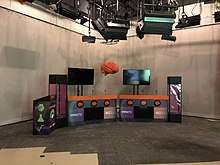WBGU-TV
WBGU-TV, virtual channel 27 (UHF digital channel 22), is a Public Broadcasting Service (PBS) member television station licensed to Bowling Green, Ohio, United States. Owned by Bowling Green State University, it is sister to radio station WBGU (88.1 FM). The two stations share studios at the Tucker Center for Telecommunications on the BGSU campus; WBGU-TV's transmitter is located near Belmore, Ohio. (While officially part of the BGSU campus, the Tucker Center is actually located two blocks south of Wooster Street, which marks much of the southern boundary of the campus.) Unlike the radio station, WBGU-TV is not primarily operated by students at the university; however, the station does offer many different student positions that allow students to gain experience.
| Bowling Green, Ohio United States | |
|---|---|
| Branding | WBGU PBS |
| Channels | Digital: 22 (UHF) Virtual: 27 (PSIP) |
| Affiliations | 27.1: PBS 27.2: PBS Kids/Encore 27.3: Create |
| Owner | Bowling Green State University |
| First air date | February 10, 1964 |
| Call sign meaning | Bowling Green State University |
| Former channel number(s) | Analog: 70 (UHF, 1964–1973) 57 (UHF, 1973–1986) 27 (UHF, 1986–2008) Digital: 56 (UHF, 2006–2010) 27 (UHF, 2010–2018) |
| Former affiliations | NET (1964–1970) |
| Transmitter power | 137 kW |
| Height | 320 m (1,050 ft) |
| Facility ID | 6568 |
| Transmitter coordinates | 41°8′12″N 83°54′24″W |
| Licensing authority | FCC |
| Public license information | Profile CDBS |
| Website | www |
History
On February 10, 1964, WBGU-TV (originally licensed to Lima but operating in Bowling Green) broadcast for the first time, and, unusually for a U.S. television station, would undergo two frequency changes in its first quarter century. The station first operated on channel 70, and moved to channel 57 in 1973 (it was the last full-power station to broadcast on a channel 70 or above in the United States); it would move to channel 27 in 1986.[1] WBGU originally wanted to move to channel 27 in the early 1970s, but protests from the nearby WGTE-TV in Toledo, which operated on the adjacent channel 30 at the time and, because of significant territorial overlap, feared confusion between the two channels, prompted state and University officials to settle for the higher channel number.[2]
The station first broadcast from a small studio located in the university's South Hall. After the Moore Musical Arts Center was built in 1979, the university's radio stations and telecommunications department (then the department of radio, television, and film) moved to West Hall, which formerly housed the university's college of music. Sometime after that, WBGU-TV moved to a new building located at 245 Troup Avenue in Bowling Green; the building was renamed the Tucker Center on May 6, 1994.
During the 1970s and early 1980s, WBGU maintained a low-powered repeater in Fort Wayne, Indiana on channel 39, W39AA (later to affiliate with Indianapolis' WFYI), which became full-powered WFWA in 1985.
Today, WBGU-TV broadcasts to nineteen counties in northwestern and west central Ohio including the markets of Toledo and Lima. With most attic antennas, WBGU's signal can be tuned in as far west as Fort Wayne and as far north as central Lenawee County, Michigan. During tropospheric conditions, it can be seen as far north as Melvindale, Michigan, 87 miles (140 km) away with a very advanced indoor antenna.

In Toledo, Buckeye Broadband carries WBGU-TV on cable channel 57, which is, ironically, the station's previous channel number on the UHF dial. No subchannels are available on Buckeye Broadband.
WBGU turned off its analog transmitter at midnight on December 14, 2008, and relocated its digital signal from channel 56 to channel 27.[3]
In 2019, WBGU-TV won an regional Emmy Award for a training video produced in conjunction with campus police to help counter active shooter threats.[4]
Digital channels
The station's digital signal is multiplexed:
| Channels | Video | Aspect | PSIP short name | Programming |
|---|---|---|---|---|
| 27.1 | 1080i | 16:9 | WBGU-DT | Main WBGU-TV programming / PBS |
| 27.2 | 480i | 4:3 | Encore | WBGU Kids 6 a.m.-6 p.m. WBGU Encore (locally produced programs) 6 p.m.-midnight The Ohio Channel midnight-6 a.m. |
| 27.3 | Create | Create |
Spectrum reallocation
WBGU-TV had considering selling off its UHF frequency as part of the digital spectrum auction, for mobile bandwidth use,[5] but pulled out late in the auction bidding process. The station remained on the air, but relocated to UHF 22 from UHF 27 on December 4, 2018.[6]
Programming

National programming produced by WBGU includes The American Woodshop, distributed by the National Educational Telecommunications Association.[7][8]
Each weekday during the academic term of public schools in the Great Black Swamp region, WBGU-TV broadcasts six hours of educational programming provided (and, in some cases, produced) by the Northwest Ohio Educational Technology Foundation. The NWOET is operated at the Tucker Center, but is a non-profit state agency separate from the university.
References
- "Archived copy". Archived from the original on 2011-07-27. Retrieved 2008-02-28.CS1 maint: archived copy as title (link)
- "Archived copy". Archived from the original on 2016-03-03. Retrieved 2012-02-09.CS1 maint: archived copy as title (link)
- "DTV - Are you Ready". Wbgu.org.
- Dupont, David. "WBGU-TV wins regional Emmy for ALICE training video – BG Independent News". Retrieved 2 July 2019.
- "Findlay Courier - Potential WBGU spectrum sale". Thecourier.com.
- "Archived copy". Archived from the original on 2017-02-13. Retrieved 2017-02-12.CS1 maint: archived copy as title (link)
- "The American Woodshop - Home". Wbgu.org.
- "American Woodshop - Search Results". Netaonline.org.
External links
- WBGU-TV website
- Northwest Ohio Educational Technology Foundation
- The Tucker Center for Telecommunications
- Query the FCC's TV station database for WBGU
- BIAfn's Media Web Database -- Information on WBGU-TV